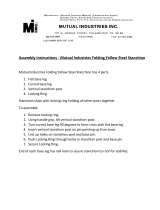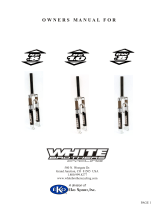Page is loading ...

Wren Suspension Fork Service Instructions
There are videos on https://wrensports.com/tech-resources/ that show how to service the Wren fork.
Air Side Service:!
!
Place your bike in a work stand and remove the front wheel.
1. Remove the blue air cap from the left leg and release all the air from the system. If your fork is a TwinAir,
be sure to empty both top and bottom air chambers.
2. Loosen and carefully remove the air spring assembly nut (large silver nut below the blue air cap) with a 26
mm socket. This nut is low profile and care should be taken to firmly engage the socket. DO NOT remove
the red air spring assembly cap.
3. Unscrew the collar on the stanchion by hand. A piece of old tube can be used as a grip. Now the air spring
can be pulled out including the air side stanchion from the bottom of the fork. !
!
Warning: At this stage please absolutely make sure again that all the air has been released from
the air spring unit to avoid severe or fatal injuries.
4. Wipe any old grease off the upper bushing and the sliding bushing on the stanchion and lightly re-grease
with a grease suitable for the temperature you will be riding in. If your fork is keyed, lightly grease the
keys. The keys can be easily popped in and out of the grooves cut to hold the keys. Do not grease inside
these grooves as that can prevent the keys from seating into the grooves properly. For general use, we
recommend Slick Honey grease.
5. Clean out any old grease in the upper tube of the fork and lightly grease all channels cut into the upper.
These are where the keys slide.
6. Looking at the top of the air spring, you will see a silver cap with 2 holes. This is the stanchion assembly
cap. Using a pair of bent nose pliers in the holes, unscrew the cap completely.
7. Grip the top of the air spring firmly and pull it out of the stanchion. This may take some effort.
8. Be sure the Large Steel Spring is well greased. All coils should be lightly filled, but not tightly packed with
grease. If riding in cold weather, be sure to use a grease specified for use in the temperature you will be
riding in. For general use, we recommend Slick Honey grease.
9. Lightly grease the air piston O-rings making sure all gaps between the black O-rings and the piston are
filled. We recommend using Molykote 55 grease for the air piston seals, but a light, white grease can be
used.
10. If you have a TwinAir fork, attach an air pump to the bottom valve and slowly add air. The TwinAir piston
that floats inside the stanchion will pop out. Grease the O-rings as described above and slide the piston
back into the stanchion. There is no top or bottom to this piston. You may have to release air from the
bottom valve as you slide this piston in.
11. Insert the air spring back into the stanchion. You will have to release air through the top valve as you push
the air spring back into the stanchion. CAREFULLY thread the stanchion assembly cap back into the
stanchion making sure not to cross-thread the cap and securely tighten with the bent nose pliers.
12. Check the grease you applied to the bushings and keys is still in place.
13. To reassemble, reverse steps 1 to 3.,If your fork is keyed, be sure to lineup the keys properly so your
dropout is in the proper position to accept the axle. Be sure the sliding bushing is completely pressed into
and flush with the upper tube before tightening the collars. Be sure to torque the air spring assembly cap
to 10 Nm. Be sure the fork collars are hand tight. Be sure to reset your air pressure and sag.!
201-588-5949・www.wrensports.com

Damper Side Service:
1. The damper is contained inside the right leg of the fork with the blue lockout lever on top. Lock the fork
using the blue lockout lever. Remember this position for the lever so you can reassemble it later.
2. If you are simply doing a clean and lube, you do not have to remove the damper. The damper is self
contained and does not need service. Should it fail, the damper needs to be replaced.
3. Remove the QR axle.
4. Turn the fork upside down. At the bottom of the leg, locate the red rebound knob. Turn the knob roughly
to the middle of its range until you can see a small hole on the side. Do not force the knob beyond its
stops. Do not remove the knob if in the fully open or closed position. Insert a 1.5 mm allen wrench
into the hole and unscrew the bolt until the knob slides off the shaft. It is not necessary to take the bolt
completely out. After sliding the knob off, it is helpful to look into the hole on the collar to see the dimple in
the shaft of the rebound fixture. During reassembly you will need to lineup the dimple and hole so the bolt
can tighten properly.
5. Using a 9 mm socket, remove the rebound fitting from the dropout. This fitting also contains the
adjustment shaft. Be sure not to lose the rubber O-ring and washer. The O-ring may stay in the bottom of
the dropout. Remove it if it does and place on the rebound fitting up against the washer.
6. Unscrew the collar on the stanchion by hand. A piece of old tube can be used as a grip. Now the damper
side stanchion can be pulled out from the bottom of the fork. Clean and lube this stanchion the same as
described for the air side in steps 4 and 5 above.
7. If you are not replacing the damper, you may insert the stanchion back into the fork and follow steps 11
and 12 below for reassembly.
8. If you are replacing the damper, using a 2 mm allen wrench, remove the bolt from the center of the blue
lockout lever on top of the fork. There is a very small ball under the lever and under the ball is a very
small spring. Carefully lift the lockout lever off the fork watching that you do not lose the ball. The spring
may stay in its hole, but you should remove as you will be turning the fork upside down later. A small allen
wrench will pick the spring out. The ball provides a small “click” feel to the compression lever and is not
required for the fork to perform, should you loose it. Locate the 27 mm silver “nut” on top of the upper leg.
This is actually the top of the damper. This nut is very low profile and care needs to be taken that the
wrench or socket is firmly engaged. Loosen and completely unscrew the nut. Remove the damper from
the upper leg. Do not remove the red cap under the nut.
9. Slowly pull the lower rod of the new damper out so that it will reach the bottom of the stanchion when
installed. If the damper is locked, you must unlock it by using the blue lockout cap or a 5 mm wrench on
the fitting on top of the damper and turning counter-clockwise. Now slowly pull the rod out until it stops.
10. Insert the damper into the upper leg and slowly push down until the threads engage in the top of the
upper leg. Hand tighten the damper. Using a 1.5mm allen wrench, loosen the 3 small bolts in the top cap
of the damper and loosen this cap slightly with a pin wrench. This will allow you to set the lockout position.
The factory setting is at 6 o’clock while sitting on the bike, but you can set anywhere. The open position
will always be 90 degrees back from lockout. Using the blue lockout cap or 5 mm wrench, lock the
damper out by turning the fitting on top of the damper clockwise a full 360° and then to your preferred
lockout position. Remove the cap or wrench, tighten the cap with a pin wrench and tighten the 3 -
1.5mm allen bolts on top of the damper. This will fix the lockout position in place. Keep the damper locked
throughout this process. Now tighten the 27 mm silver nut to 12.5 Nm with a torque wrench. If you ever
have a situation where the blue lockout lever continues to turn beyond your lock out position, then this
cap has come loose.
11. Turn the fork back upside down and reassemble the rebound fitting. First, look into the hole on the bottom
of the drop out and ensure the shaft of the damper is centered in the hole. There is a slight depression on
the inside of the dropout that the shaft sits in. By inserting an allen wrench through the hole into the shaft,
you can gently move the shaft to center it while gently pushing in on the dropout. The shaft should sit in
the depression and stay centered. Now thread the rebound fitting into the shaft. Tighten the 9 mm nut to 5
Nm with a torque wrench.

12. Now you must lineup the dimple on the shaft, the hole in the collar and the allen bolt in the red rebound
knob so that the allen bolt tightens through the hole in the collar and into the dimple on the shaft. Look
through the hole in the collar to locate the dimple on the shaft. If you don’t see the dimple, slowly turn the
shaft only, while looking for the dimple to appear. A small amount of the shaft extends beyond the fitting to
allow you to turn it. Needle nose pliers are good for doing this. Once everything is lined up, slide the
rebound knob onto the fitting and use a 1.5 mm allen wrench to tighten snugly. The allen bolt should
thread well into the knob. If the bolt tightens almost immediately or is visible outside the knob, you have
tightened on the collar, not into the dimple. It is important that you take the time to do this step correctly.
Do not over tighten, just a snug fit. If too tight, the shaft will not turn properly. When tightened correctly,
the red rebound knob will turn smoothly. If the knob is hard to turn, back off the allen bolt slightly. The
allen bolt has loctite applied to it. Over time this could wear off and new loctite should be applied.
13. Now turn the fork back upright and reassemble the blue lockout lever from step 3. Notice that there are 6
small holes on top of the damper. Three have small allen bolts visible and 3 are open. Lightly grease the
spring and insert into one of the open holes. Place the ball on top of the spring.
14. Next, place the blue lockout lever on top of the damper in the lockout position you selected and push
down to secure. Insert the allen bolt and tighten snugly with a 2 mm allen wrench. Do not over tighten.
Reapply loctite to this bolt, if necessary.
15. Damper replacement is complete. Remember, if necessary, to refill the air spring and reset your sag before
riding.
Should you ever have any questions or need any parts for your fork, please call 201-588-5949 or email
Thank you for riding Wren!

/

